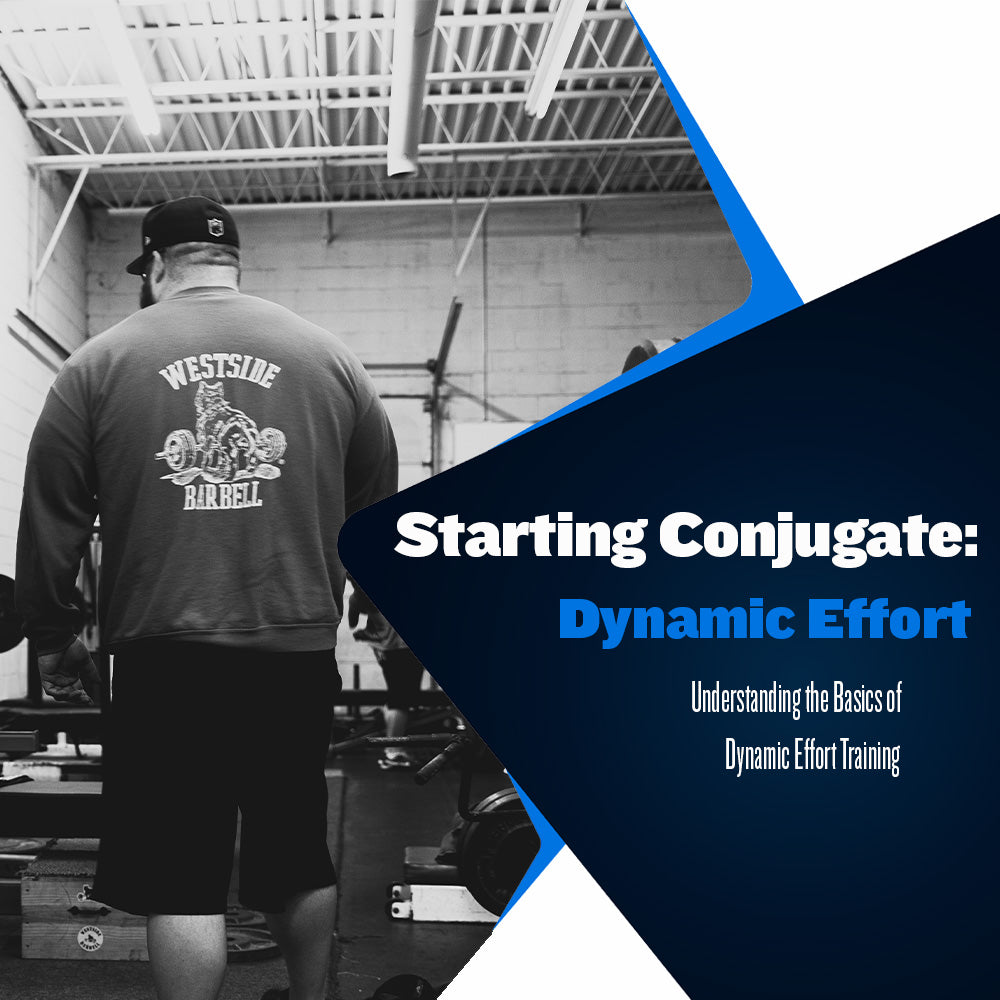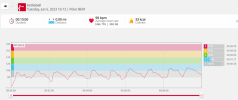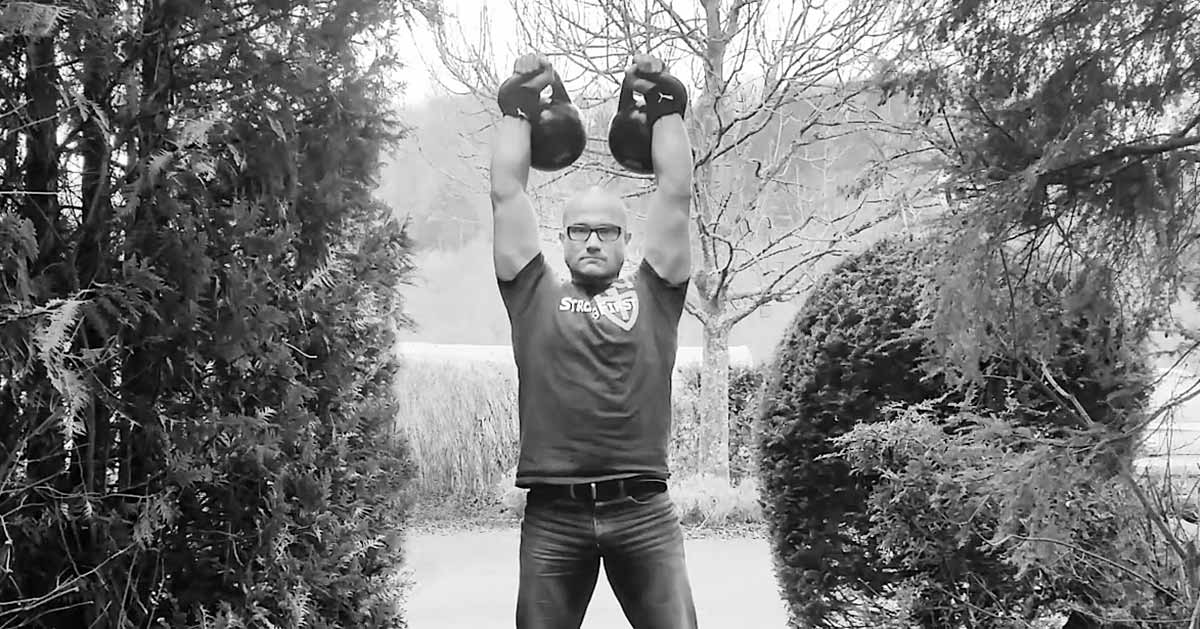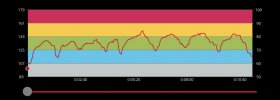You are using an out of date browser. It may not display this or other websites correctly.
You should upgrade or use an alternative browser.
You should upgrade or use an alternative browser.
Another HR & A+A thread
- Thread starter Steve Freides
- Start date
Do you plan on keeping the duration around 11 minutes ?View attachment 21629
2h swings x 5. Waited until HR was in Zone 2 before starting each net set.
Comments on this as A+A training? Considering getting used to this and doing it 2-3x/week as part of my powerlifting training.
Thanks in advance for your comments and suggestions
-S-
Do you plan on keeping the duration around 11 minutes ?
I don't know.
The twin, and conflicting, goals are conditioning/work capacity on the one hand, and assisting my barbelll deadlift on the other. I don't think 48 kg is heavy enough to do my deadlift much good but I honestly don't know. 56 kg is about 1/3 of my 170 1RM so that seems a better fit. I also have a 64 kg but that seems like it's more than I need - I think the 56 kg for 2h swings will be the sweet spot for my purposes.
My training time is precious, so this was 10 minutes and as many as I happened to get in. I'm comfortable doing more than 5 reps (with the 48 kg I used) in this amount of time and recovering sufficiently, I think, so that's one option for progress, maybe go to 6 reps or 7. Another option, since I'm a competitive deadlifter, is going with a heavier weight. I'm good for at least 10-12 solid reps with a 56 kg if I take long rests, so switching to a heavier weight, keeping 5 reps, and keeping the time the same is another option. The nice thing about this 10-minute session was that I bench pressed shortly afterwards and it didn't feel like the swings took anything away from my strength for the BP.
Too many choices and multiple goals. This was just a shot in the dark for my first go at this.
-S-
BJJ Shawn
Level 6 Valued Member
This is how I do almost all of my swing sessions over the past # of years, including the 10,000 swing challenge. I have never worried about the max HR reached, but rather beginning my sets when my HR gets back to a set number (I use 130-135 @ 40 years old).
I really like this way of doing A+A, as rest naturally increases as the session goes on. What I find interesting is there is a point that it dramatically increases, and this is a good place to stop. For instance, minutes 1-30 I may need 45-55 seconds to recover, and then all over a sudden I need 1:30-2:00 minutes.
This is similar to how Pavel describes the stop sign for A+A in KBSF, except with HR instead of the talk test. There is definitely a wall where it changes suddenly, and the more sessions I do the quicker my recovery is during the "good" part of the session and the longer before I hit that wall, so I know it works.
I really like this way of doing A+A, as rest naturally increases as the session goes on. What I find interesting is there is a point that it dramatically increases, and this is a good place to stop. For instance, minutes 1-30 I may need 45-55 seconds to recover, and then all over a sudden I need 1:30-2:00 minutes.
This is similar to how Pavel describes the stop sign for A+A in KBSF, except with HR instead of the talk test. There is definitely a wall where it changes suddenly, and the more sessions I do the quicker my recovery is during the "good" part of the session and the longer before I hit that wall, so I know it works.
I know your MAF HR is 112-113, guessing the ave. in the above session is around 136. My first thought was to get you to 20 + minutes with a lower HR, to get some good motor work in without bothering your DL. I was figuring you were swinging at least 40KG, which swung with power I believe will help your DL. Same with the 48 and 56. As it sits I'd keep doing the above. but would add to the 8 rounds by a couple rounds a week. as an experiment. And I would think the 40 or 48 would be plenty. Trying to keep you out of the GREY ZONE,I don't know.
The twin, and conflicting, goals are conditioning/work capacity on the one hand, and assisting my barbelll deadlift on the other. I don't think 48 kg is heavy enough to do my deadlift much good but I honestly don't know. 56 kg is about 1/3 of my 170 1RM so that seems a better fit. I also have a 64 kg but that seems like it's more than I need - I think the 56 kg for 2h swings will be the sweet spot for my purposes.
My training time is precious, so this was 10 minutes and as many as I happened to get in. I'm comfortable doing more than 5 reps (with the 48 kg I used) in this amount of time and recovering sufficiently, I think, so that's one option for progress, maybe go to 6 reps or 7. Another option, since I'm a competitive deadlifter, is going with a heavier weight. I'm good for at least 10-12 solid reps with a 56 kg if I take long rests, so switching to a heavier weight, keeping 5 reps, and keeping the time the same is another option. The nice thing about this 10-minute session was that I bench pressed shortly afterwards and it didn't feel like the swings took anything away from my strength for the BP.
Too many choices and multiple goals. This was just a shot in the dark for my first go at this.
-S-
which would be too hard for easy motor building base, and too easy for building power and cardiac output.
And your chart reminded me a bit of this, dynamic or speed day.

 www.westside-barbell.com
www.westside-barbell.com

The Basics of Dynamic Effort
As stated before, the Conjugate Method is the most complete and efficient method to train an athlete for any sport. It's simple; instead of committing large blocks of training time to develop specific strengths or abilities, the Conjugate Method allows an athlete to train multiple types of...
 www.westside-barbell.com
www.westside-barbell.com
Adachi
Level 7 Valued Member
I keep going over materials from @Fabio Zonin and I keep seeing Ladders.The twin, and conflicting, goals are conditioning/work capacity on the one hand, and assisting my barbelll deadlift on the other.
I would be curious about 48kg 2,3,5 ladders given your goals.
Last edited:
I love how Polar has a "kettlebell" activity now...
I tried a similar session just now, Steve, except I used a 32 kg. I also did 2H swings in sets of 5; powerful, as I'm sure yours were I did my OTM but about the same HR recovery.
I did my OTM but about the same HR recovery.

Personally I think it's the pattern more than the recovery HR value that matters. HR goes up with and just after the effort, recovers to what is the recovery HR for the session (that day, the chosen weight, the exact reps or duration of the working set)... repeat. If you recover to something that's higher than the recovery HR for the session (too short of a rest), then you'll see an upward trend as the session goes on. I tend to think that the upward trend is something to avoid with "classic" A+A, though it certainly doesn't spoil the entire recipe, and it may lead to other positive adaptations. If you wait longer than necessary, I don't think there's much negative effect, except perhaps some wasted time.
I also think the HR "zone" matters very little for A+A's most important objectives, which are, in my mind, a low-stress way to get in a decent volume of high power training, and let the body get really good at recovering from hard efforts and being ready to go again.
And as to whether to use the HR value as a guide vs. sensations as a guide (breathing settled, a feeling of readiness and restoration for the next set) -- IMO the second is better, but the first can also get you in the ballpark and has its advantages as well.
And as far as where to go with your A+A towards your goals, I agree with @Don Fairbanks' thinking.
I tried a similar session just now, Steve, except I used a 32 kg. I also did 2H swings in sets of 5; powerful, as I'm sure yours were

Personally I think it's the pattern more than the recovery HR value that matters. HR goes up with and just after the effort, recovers to what is the recovery HR for the session (that day, the chosen weight, the exact reps or duration of the working set)... repeat. If you recover to something that's higher than the recovery HR for the session (too short of a rest), then you'll see an upward trend as the session goes on. I tend to think that the upward trend is something to avoid with "classic" A+A, though it certainly doesn't spoil the entire recipe, and it may lead to other positive adaptations. If you wait longer than necessary, I don't think there's much negative effect, except perhaps some wasted time.
I also think the HR "zone" matters very little for A+A's most important objectives, which are, in my mind, a low-stress way to get in a decent volume of high power training, and let the body get really good at recovering from hard efforts and being ready to go again.
And as to whether to use the HR value as a guide vs. sensations as a guide (breathing settled, a feeling of readiness and restoration for the next set) -- IMO the second is better, but the first can also get you in the ballpark and has its advantages as well.
And as far as where to go with your A+A towards your goals, I agree with @Don Fairbanks' thinking.
Steve W.
Level 8 Valued Member
Classic A+A is to Kettlebells StrongFirst A+A as Classic Coke is to New Coke"classic" A+A
+1,000,000If you wait longer than necessary, I don't think there's much negative effect, except perhaps some wasted time.
I also think the HR "zone" matters very little for A+A's most important objectives, which are, in my mind, a low-stress way to get in a decent volume of high power training, and let the body get really good at recovering from hard efforts and being ready to go again.
And as to whether to use the HR value as a guide vs. sensations as a guide (breathing settled, a feeling of readiness and restoration for the next set) -- IMO the second is better, but the first can also get you in the ballpark and has its advantages as well.
My MAF HR, according to my Polar app, is 125. My max HR, actual, is 179. Polar says 129 average, 147 max for this session. I assume MAF to be the highest number in my Zone 2. All that in the “for what it’s worth” department.I know your MAF HR is 112-113, guessing the ave. in the above session is around 136.
Andy talks about doing 5x5 and working with each weight until you can do each new set on the minute. I agree that 48 kg or a bit on either side of that seems to be the right weight. But I suspect Andy isn’t trying to recover into a Zone 2 HR.Looking at what Andy Bolton talks about swinging in his article, in terms of % 1RM and % bodyweight makes me think you are definitely in the "useful zone."
-S-
I don’t know why but the talk test and other breathing-related tests are not reliable indicators for me. I’ve maxed out my HR while breathing nasally only, and maybe it’s because I play trumpet and French horn every day, but, well, I think recovering to 125 will be ok for me. I’ve actually noticed, when out for a walk, that when the road turns uphill, around 125 is where I start feeling like I’m not recovering easily.I also think the HR "zone" matters very little for A+A's most important objectives, which are, in my mind, a low-stress way to get in a decent volume of high power training, and let the body get really good at recovering from hard efforts and being ready to go again.
-S-
Yes, perhaps playing musical instruments. Also Buteyko breathing practice could affect respiration as an indicator.I don’t know why but the talk test and other breathing-related tests are not reliable indicators for me. I’ve maxed out my HR while breathing nasally only, and maybe it’s because I play trumpet and French horn every day
I think it would be fine. But you might find that your "equivalent 125 point" might be somewhat different on any given day. For example, our patterns are similar in the graphs above, and I think they're both about right, but mine is at a lower baseline HR. Partly because you're swinging 48 kg and I'm swinging 32 kg. But there could be other confounders. Based on past experience, mine would be higher (with equivalent load/timing/reps) if it was in the morning and I'd had caffeine, if I was more warmed up with something else prior, if I was a bit more stressed out (sympathetic dominant), if I was less recovered (although sometimes that works the opposite way too -- I found that some days if I was quite under-recovered, my HR would just stay lower than normal and my body had reluctance to even step up to the training task -- I perceived it to be parasympathetic dominance). FWIW, my numbers are similar to yours -- MAF HR about 125, actual max about 179, resting HR usually 50-52.I think recovering to 125 will be ok for me
Makes sense, I was using the MAF 180 formula and forgot to add 10 beats for a fit person 65 or older.My MAF HR, according to my Polar app, is 125. My max HR, actual, is 179. Polar says 129 average, 147 max for this session. I assume MAF to be the highest number in my Zone 2. All that in the “for what it’s worth” department.
Andy talks about doing 5x5 and working with each weight until you can do each new set on the minute. I agree that 48 kg or a bit on either side of that seems to be the right weight. But I suspect Andy isn’t trying to recover into a Zone 2 HR.
-S-
Adachi
Level 7 Valued Member
As a tuba player , I do use the talk test which is usually pretty rapid. But now I couple that with heart rate. I look for a tempo at around 140 or so. Which from my memory is Stars and Stripes forever. Once that march starts sagging by my heart rate I know I'm in the 130s.maybe it’s because I play trumpet and French horn every day
If I go by talk test I can get myself into overwork territory. And I have.
I do also look for what I would refer to as freshness in the working muscles.
But all this is very tiresome and makes me want for a timer to go by.
Christophe
Level 4 Valued Member
If I remember correctly from the comment section of one of Pavel’s articles about A+A (I believe it is the one with the C&J) he stated that HR in the talk test is significantly higher than MAF HR, so that should be fine.
This is an interesting subject. As a generalization about myself, I think I'm less "variable" than you describe yourself. Well, that or I'm delusional, the latter being also a distinct possibility.I think it would be fine. But you might find that your "equivalent 125 point" might be somewhat different on any given day. For example, our patterns are similar in the graphs above, and I think they're both about right, but mine is at a lower baseline HR. Partly because you're swinging 48 kg and I'm swinging 32 kg. But there could be other confounders. Based on past experience, mine would be higher (with equivalent load/timing/reps) if it was in the morning and I'd had caffeine, if I was more warmed up with something else prior, if I was a bit more stressed out (sympathetic dominant), if I was less recovered (although sometimes that works the opposite way too -- I found that some days if I was quite under-recovered, my HR would just stay lower than normal and my body had reluctance to even step up to the training task -- I perceived it to be parasympathetic dominance).
Yes, quite similar. I haven't taken a true resting pulse in a long time, but my watch tells me that, sitting here in my chair at the computer after having been up and about for a few hours, my pulse was 59 bpm, so a true resting pulse a few bpm lower than that seems reasonable to assume.FWIW, my numbers are similar to yours -- MAF HR about 125, actual max about 179, resting HR usually 50-52.
If you or anyone can find a link to that, it would be interesting to read the original. Thanks in advance.If I remember correctly from the comment section of one of Pavel’s articles about A+A (I believe it is the one with the C&J) he stated that HR in the talk test is significantly higher than MAF HR, so that should be fine.
If the rest of you will forgive a dive into music geekdom ... Several people I know consider march tempo to be 120, not 140.As a tuba player , I do use the talk test which is usually pretty rapid. But now I couple that with heart rate. I look for a tempo at around 140 or so. Which from my memory is Stars and Stripes forever. Once that march starts sagging by my heart rate I know I'm in the 130s.
I get about 125 from the above recording.
Yes, my situation, exactly.If I go by talk test I can get myself into overwork territory. And I have.
-S-
Adachi
Level 7 Valued Member
Far be it from me to launch any kind of criticism against The President's Own.If the rest of you will forgive a dive into music geekdom ... Several people I know consider march tempo to be 120, not 140.
As a Military Musician, myself, I have nothing but the highest regard for this organization, and this recording is rather spotless. It's arguably perfect.
- However -
To elucidate my position, I've been playing for ceremonies for nigh-on a 2-decade-long career.
March Tempo is Nominally 120. Usually, a good place to start. Always good for a sit-down gig, especially in quintets.
British Marches should almost always be played markedly slower, and more regal. as slow as 110-112. It's painful sometimes, but it's its own thing. And, it is often demanded by rhythmic features that highlight the chord changes in the song a bit more prominently; having a unique musical effect. The weightiness is intentional.
There are Quickstep marches which - depending on your interpretation - would be 90 or 180 bpm but are meant to have the effect of being applied to a running tempo, often literally intended to coincide with a horse trotting on the field.
On the Parade Field, in formations, the tempo of a given march will be somewhere around 112-118 - depending on what the troops will cooperate with. it's always less than 120, the question is only by how much. this is most felt by the trumpets holding high notes. Our percussion section targets 116. We have played Stars and Stripes on the parade field upon request, for reasons I'll explain below, it is not our preferred choice.
- In our concerts -
Stars and Stripes was reserved as a closer, and was played last; often as an encore.
in which case to serve the audience, and to top the energy levels of the rest of the show - we played it at ~138 - and pushed the last repeat to about 142.
it served a valuable purpose.
we are far from alone, in this. it is a rather common practice. and my peers from other bands would mention it - and ask us if we didn't. they might say it seemed a bit sluggish.
My memory is stuck with our elevated-tempo version of this song.
for me, Stars and Stripes are useful for telling me that I'm back in zone 2 range HR.
to get down to 120 or a little less, I'll go with something like Joyce's, or Bravura.
- take away message for others -
if you learn the tempos of memorable songs they can help you find heartrate BPMs with a useful amount of accuracy, and rather quickly.
You can probably make a short list of songs that correlate with a good range of tempos.
Example:
It's My Life, Bon Jovi ~120 bpm
Girls, Girls, Girls; Motely Crue ~140 bpm
She Loves You, Beatles ~150 bpm
Don't Stop Me Now, Queen ~160 bpm
Apologies for the digression.
Last edited:
Christophe
Level 4 Valued Member
If you or anyone can find a link to that, it would be interesting to read the original. Thanks in advance.
-S-

The Best All-Around Training Method EVER | StrongFirst
This method, while it does not maximize the development of any of the above qualities—only a highly specialized method, not a general physical preparation one, could do that—it develops them to levels high enough to successfully compete in amateur sports, excel at physically demanding...
www.strongfirst.com
It is in the comment section.
- Pavel Tsatsouline says:
January 24, 2022 at 8:46 am
Thank you, Bauer.
If you can pass the talk test, your HR will not redline (you will be way above MAF but MAF is not the goal). You might not reach step 3 and it is OK.

